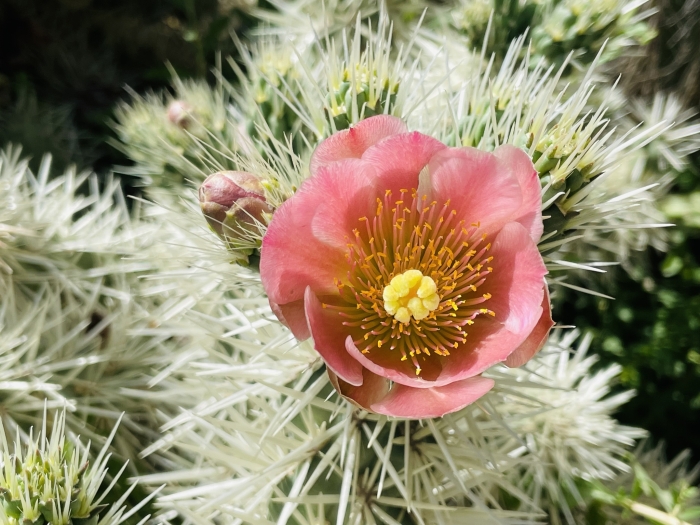Sheathed Cholla
(Cylindropuntia tunicata)
Sheathed Cholla (Cylindropuntia tunicata)
/
/

© Francisco E. Fonturbel
CC BY 4.0
Image By:
© Francisco E. Fonturbel
Recorded By:
Copyright:
CC BY 4.0
Copyright Notice:
Photo by: © Francisco E. Fonturbel | License Type: CC BY 4.0 | License URL: http://creativecommons.org/licenses/by/4.0/ | Uploader: fonturbel | Publisher: iNaturalist |

























Estimated Native Range
Summary
Cylindropuntia tunicata, commonly known as sheathed cholla and also referred to as Brown-spined Hudson pear, is a perennial shrub that is part of the cactus family. It is native to arid and semi-arid regions, specifically the Chihuahuan Desert of North America. This cactus typically grows in open areas, desert grasslands, and rocky slopes. It can reach heights of 3 to 5 feet (0.9 to 1.5 meters) and has a distinctive appearance with segmented branches covered in a sheath of tan to brown spines that can be up to 3 inches long.
Sheathed cholla is known for its resilience in harsh desert conditions, requiring minimal water and thriving in well-drained sandy or gravelly soils. It prefers full sun exposure. The plant produces greenish-yellow flowers that bloom in late spring to early summer, adding a splash of color to the landscape. However, its spines are a significant concern as they can cause injury to humans and animals and damage equipment. In cultivation, it is used primarily in xeriscaping and as a barrier plant due to its spiny nature. Gardeners should handle it with care and plant it away from high-traffic areas. It is considered an invasive species in Queensland, Australia, where it affects agriculture by invading pastures and natural areas.CC BY-SA 4.0
Sheathed cholla is known for its resilience in harsh desert conditions, requiring minimal water and thriving in well-drained sandy or gravelly soils. It prefers full sun exposure. The plant produces greenish-yellow flowers that bloom in late spring to early summer, adding a splash of color to the landscape. However, its spines are a significant concern as they can cause injury to humans and animals and damage equipment. In cultivation, it is used primarily in xeriscaping and as a barrier plant due to its spiny nature. Gardeners should handle it with care and plant it away from high-traffic areas. It is considered an invasive species in Queensland, Australia, where it affects agriculture by invading pastures and natural areas.CC BY-SA 4.0
Plant Description
- Plant Type: Succulent
- Height: 4-6 feet
- Width: 3-5 feet
- Growth Rate: Slow
- Flower Color: Green, Yellow
- Flowering Season: Spring, Summer
- Leaf Retention: Evergreen
Growth Requirements
- Sun: Full Sun
- Water: Low
- Drainage: Fast
Common Uses
Drought Tolerant, Fire Resistant, Low Maintenance, Rock Garden
Natural Habitat
Native to arid and semi-arid regions of the Chihuahuan Desert in North America
Other Names
Common Names: Sheathed Cholla, Clavellina, Coyonoxtle, Tencholote, True Cholla
Scientific Names: , Cylindropuntia tunicata, Cactus tunicatus, Cereus tunicatus, Cylindropuntia tunicata var. aricensis, Cylindropuntia tunicata var. chilensis, Grusonia tunicata, Opuntia exuviata, Opuntia exuviata var. angustior, Opuntia exuviata var. spinosior
GBIF Accepted Name: